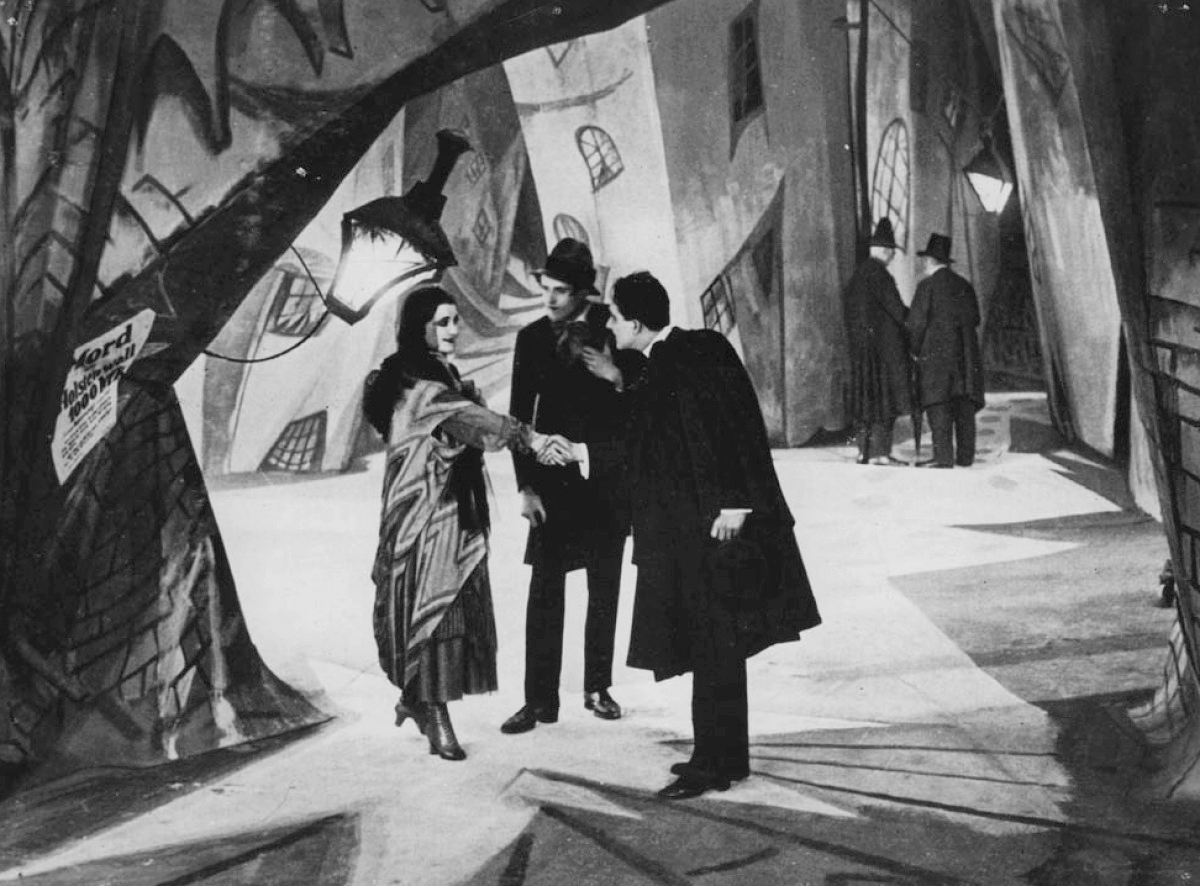The Cabinet of Dr. Caligari


Spoiler alert.
There is a guy. He has a friend. They both like the same girl.
There is a man who calls himself Dr. Caligari. He has a carnival act, what he calls a “somnambulist.”
Dr. C is mistreated by an impatient clerk.
The clerk is found stabbed to death in his bed. This upsets the citizenry.
The guy and his friend go to the carnival and see Dr. C and his somnambulist, whose name is Cesare.
Cesare, played by Conrad Veidt, has a thin, weird, unsettling, ![]() urbaniak-style creepiness about him. He sleeps in a coffin, the “cabinet” of the title. (For unrivalled creepiness, check him out in The Man Who Laughs, where he inspired the Batman folks to create The Joker.)
urbaniak-style creepiness about him. He sleeps in a coffin, the “cabinet” of the title. (For unrivalled creepiness, check him out in The Man Who Laughs, where he inspired the Batman folks to create The Joker.)
Dr. C says that Cesare can tell the future. The guy’s friend steps forward and says, with a laugh, “How long will I live?” Cesare stares at him with his Urbaniak glare and says “’til break of day.”
That night, Dr. C sends the sleepwalking Cesare out into the night to murder the guy’s friend in his bed. He does so. This upsets the citizenry.
The guy now has the girl, but she’s upset because the friend has been stabbed to death in his bed. Her father, sensitive to this type of thing, goes to investigate the doctor and his somnambulist. The father goes out to the fairgrounds and finds that a dummy rests in Cesare’s coffin.
Cesare, at that moment, has gone to the girl’s house to kill her. He is startled in his efforts by some local citizenry, who chase him through town (shades of Fritz Lang’s M).*
The guy goes chasing after Dr. C and follows him to an insane asylum. The staff of the asylum grab the guy, who is hysterical. He insists that the man responsible for the death of his friend and the abduction of his fiancee is in their asylum. The orderlies take the guy to the head doctor, who turns out to be — yes, Dr. Caligari.
The guy waits until the doctor is out of his office, then ransacks his files until he finds the proof that he is behind the mysterious murders in town. It seems that this doctor, inspired by an Italian man named Dr. Caligari, decided to perform an experiment on a cataleptic, to see if he could get a sleeping man to do things he would not do when awake. Once he had done so, it appears that the doctor got a little carried away, getting poor Cesare to kill just about anyone who inconvenienced the doctor.
The guy, burning with righteous fury, accuses the doctor, who denies everything until the body of the dead Cesare, who has apparently collapsed in a field outside of town, is brought in. At this point, the doctor also collapses, in grief, and spills the beans about his psychiactric misdeeds. He is bound in a strait-jacket and carted off to one of his own cells.
All well and good. But then, in a Donald Kaufman-esque twist ending, we PULL BACK TO REVEAL that this tale is being told to us by the guy, who, for some reason, STILL LIVES AT THE INSANE ASYLUM. We come to find that his fiancee is there, and Cesare too, and that they’re all quite stark raving mad. So apparently none of this involving tale is true.
In addition to the twist ending (or as M. Night Shamalyan calls them the “paradigm shift”), there’s the matter of the sets.
They are deliberately weird, fake, flat, hand-made, crazy, unsettling and bizarre. Unlike anything that’s been done before or since, I don’t know why. And at first you’re like “What’s with the sets?” But then, when the twist ending comes, you say “Oh, I see, because the narrator is crazy.” Frankly, I don’t know why this experiment has never been repeated. Only recently, with movies like Sin City and A Scanner Darkly has this kind of heavily stylized, deliberate artificiality found its way into a mainstream feature. Correct me if I’m wrong.
And, of course, I’m thinking about a remake.
The thing I like best about the movie, aside from the visionary sets and the ahead-of-its-time narrative, is the film’s ideas about guilt. Dr. C has found a way to commit evil acts with a clean conscience — he’s not the one killing people, Cesare is. Cesare, on the other hand, also feels no guilt because he doesn’t even know that he’s killing anyone. People die, citizenry is hysterical, and no one has to pay a penalty. No one is guilty. No wonder the protagonist has gone insane.
*smarty-pant film students will recall that Lang was first asked to direct Caligari.
